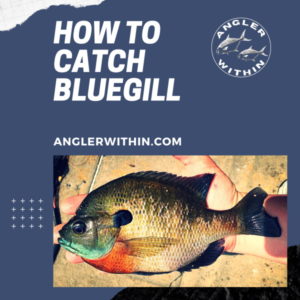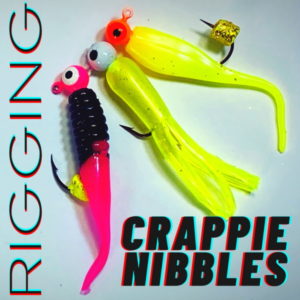*As an Amazon Associate I earn from qualifying purchases.

Loop knots are key to getting the most accurate and lively presentation from your crappie jigs. There are several excellent loop knots discussed below, along with videos on how to tie each of them.
2 Advantages Of Loop Knots For Crappie Jigs
Better Presentation
Loop knots provide a more natural lure presentation, as the jig can hang properly and swing about freely. A jig tied with this type of knot will sit horizontally in the water as it was designed to do. On the other hand, a directly tied knot, such as the palomar, can slide up or down on the eye of the jig, and cause the bait to sit diagonally in the water.
Saves Time Throughout The Day
If you don’t use a loop, you’ll need to constantly check your bait to ensure the knot is in the proper position. Although they’re initially more time consuming to tie, loop knots save time throughout the day since you won’t have to constantly re-adjust your knot.
Proper presentation, no mater how minor it seems, can have a big impact on how many crappie you entice. The loop knot goes a long way in ensuring you have the best presentation, and thus the best shot at catching fish.
3 Negatives Of Loop Knots
There are of course a few disadvantages to using loop knots. In spite of the 3 negatives discussed below, I still think the benefits outweigh the negatives, except perhaps in the last scenario.
They Take Longer To Tie
Loop knots do take longer to tie than other knots that you may already be comfortable with. You can overcome most of that time difference as you use them more and more.
Loop Knots Are More Visible
Loops are also more visible than smaller knots, but if you’re using small diameter line for crappie, this shouldn’t matter at all. This certainly doesn’t matter if you’re fishing in stained water.
They Can Get Dirty
Finally, this kind of knot does tend to grab more debris and scum from the water than other knots. In a dirty lake, like the one I fish, this can be an issue. Some areas of my home lake are “normal” dingy water which is fine. Other areas are extremely dirty and I typically avoid the loop knot in those areas. Otherwise I’m constantly picking scum and debris off of the knot.
3 Best Loop Knots For Crappie Jigs
The 3 best loop knots I’m aware of are the Rapala, surgeon’s and the non-slip loop knot. Each one is discussed below with a link to my Youtube video on how to tie them.
1. Rapala Loop Knot
The Rapala knot is one of the strongest loop knots available but it does have a downside. Once tied, the tag end points away from the lure thus making this knot more likely to pick up debris in the water. Check out my video below on how to tie the classic Rapala loop knot.
2. Non Slip Single Loop Knot
Perhaps a bit better than the Rapala knot for crappie fishing is the “Non Slip Loop Knot“. It’s pretty much just a Rapala loop knot but excluding the very last step of the process. This exclusion of the last step slightly reduces the knots strength, but not to a degree that it matters much when it comes to crappie fishing.
The difference is that you just don’t pass the tag end back through the “upper loop” as you are finishing up the knot. This results in the tag end pointing towards the jig, as shown below, whereas the Rapala loop results in the tag end pointing away from the jig. This is preferable since the non-slip design, with it’s weedless tag end, will hang less debris in the water.
3. Surgeon’s Loop Knot
The Surgeon’s Loop Knot is perhaps the best of the 3. Not because it’s the strongest, and not because it’s the most weedless, but because it’s the simplest to tie. All you do is simply loop the jig around the doubled up main line 2 or 3 times and cinch it down. Easy as that! Check out my video below on how to tie this knot. You really can’t go wrong with any of these 3 options.
Some Final Tips
Loop Size
When you’re tying a loop knot, the goal isn’t necessarily to get the loop as small as possible. Actually bigger loops, up to a point, are sometimes better. I’m fine with anywhere between 1/4″ and 3/4″ long loops, but you can even go a little bigger than that. If my loop comes out longer than 3/4″, that’s fine. If you find that your jig is getting tangled up in the loop, just drop your loop size back a bit.
What About When Using Braid
Yes, you can still use these 3 knots when fishing with braided fishing lines. The Rapala loop knot, in particular, works great with braid. I’m sure the others do as well.
2 Alternatives To Using A Loop Knot For Crappie
No Loop
You could of course choose to not use a loop at all. I did so for many years and caught plenty of crappie. You just need to be sure to check your jig after every fish to make sure the knot is still sitting in the correct position on the eyelet. Refer to the image at the top of the article on what NOT to do.
Snaps
There are many tiny snaps on the market that will work fine in place of a loop knot. Below are a couple great snaps that are popular. These fishing snaps are geared towards fly-fishermen, so when searching for them locally, you may have to check a different area of the store than you are used to. Tie your snap to your line using a palomar or improved clinch knot, or whatever your personal preference is.
* Click image above to view prices on Amazon
Advantages Of Snaps
The biggest advantage of a snap is that you only have to tie 1 knot and can quickly change jigs as desired. We all know how often we crappie fishermen like to change jigs throughout the day!
Disadvantages Of Snaps
There are several downsides to using snaps. First of all, you have more hardware in your setup, which isn’t ideal in clear water. You also have additional cost in your setup that could be argued to be unnecessary. Finally, because snaps are so small, they can be a pain to handle. You may need pliers in order to pull the snap off of a jig. Nevertheless, above are 2 good snaps to use for crappie jigs. The second one is the No Knot Fas-Snap which is a very popular choice.
Conclusion
Loop knots may seem a tad intimidating at first, if you’ve never used them. Trust me, they’re actually quite easy to tie, once you commit to using them on a regular basis. A seasoned crappie angler knows how finicky a crappie can be, and at times, the loop knot can definitely be the difference in catching fish or not. Give them a try!
Good Luck!
Augustus Clay
If you enjoyed this article, you might also be interested in my article about the 3 best baits for crappie linked here.





